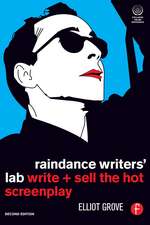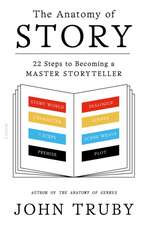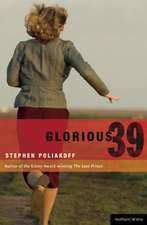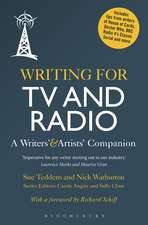Writing the Horror Movie
Autor Marc Blake, Sara Baileyen Limba Engleză Paperback – 11 sep 2013
Preț: 179.98 lei
Preț vechi: 222.87 lei
-19% Nou
Puncte Express: 270
Preț estimativ în valută:
34.45€ • 37.43$ • 28.96£
34.45€ • 37.43$ • 28.96£
Carte disponibilă
Livrare economică 31 martie-14 aprilie
Preluare comenzi: 021 569.72.76
Specificații
ISBN-13: 9781441196187
ISBN-10: 1441196188
Pagini: 272
Ilustrații: 20
Dimensiuni: 152 x 229 x 23 mm
Greutate: 0.41 kg
Editura: Bloomsbury Publishing
Colecția Bloomsbury Academic
Locul publicării:New York, United States
ISBN-10: 1441196188
Pagini: 272
Ilustrații: 20
Dimensiuni: 152 x 229 x 23 mm
Greutate: 0.41 kg
Editura: Bloomsbury Publishing
Colecția Bloomsbury Academic
Locul publicării:New York, United States
Caracteristici
Includes a suggested viewing list of fifty top horror movies, with analysis of each subgenre.
Notă biografică
Marc Blake has written for the Independent on Sunday, the Evening Standard, The Mail, Express and the Scriptwriter as well being a freelance writer on Eagle Moss' 'The Horror Collection'. He now teaches horror film at Southampton Solent University, UK, on their graduate programme. He is the author of three novels, Sunstroke, Big Time, and 24 Karat Schmooze.Sara Bailey is Course Leader for Screenwriting at Southampton Solent University, UK. She has worked as a screenwriter and is an experienced researcher and lecturer.
Cuprins
Introduction: Welcome to the Nightmare 1. Why do we like to be scared? On the Abject and the Unknown 2. Horror history and literary/film background3. Subgenres. The Undead. Monsters. Demons and possession. Serial Killers, Slashers, Werewolves, Bad science and Body Horror4. Staging horror. Five tropes. Unease, dread, terror, horror & disgust5. On creating the Nemesis: Norman, Hannibal, Freddie and Jigsaw6. Forming the idea. Writing exercises. Fears and phobias. Notes on the screenplay. Short, visual and credible7. The First Act: Unease and dread. Character and milieu8. The Second Act: Modulating fear, terror and horror9. Third Act. Resolutions. Tragic and redemptive endings10. Writing the horror sequel/franchise11. Adaptations. From page to screen. Short stories and novels12. On Cross-genre. Where can you bleed into other genres? Zom-Com, Thriller/Horror, Vampire romance, Horror and comedy13. World markets. Horror in the US, the UK and European Horror. Asian, Thai and Hong Kong horror14. Lo-budget Horror. How Blair Witch, Colin and Paranormal Activity became box office gold15. Case studies. Selling the scare. Interviews with Writer/directors Chris Smith (Creep, Severance), James Watkins (Eden Lake). Neil Marshall (Dog Soldiers, Descent, Doom), Adam Gierasch (Autopsy, Night of the Demons) Mark Ezra and more.... 16. Producer Interviews. What producers are looking for? 17. Marketing. Frightest and Sitges. Interviews with directors of the world's leading Horror festivals and conventions 18. Fifty Essential Horror movies. Synopses and analysis of each subgenre.
Recenzii
The truth is that the screenplay is a bastard form of literature. It is not a play nor book nor movie, and not just simply a blueprint for a film. All movies, regardless of genre, depend on the screenplay. However it is the director who makes the movie by realizing the printed words of the script on film. I have seen mediocre screenplays made into very good films. And I have seen excellent screenplays made into bad movies by incompetent directors. Again, it's important for people to understand that the screenplays essential role in film making is the same regardless of the genre of the film. --John Landis, 2012
Writing the Horror Movie is written in particular for anyone interested in writing a screenplay for a horror film, and in seeing that screenplay turned into reality. But it's also full of fascinating nuggets of analysis and useful information more generally for scholars, students and fans of the genre - whether this is musing on the aesthetics of disgust, offering nifty psychological profiles of major horror monsters, or advice on how to exploit your film and turn it into a lucrative franchise. Two dismembered thumbs up for Marc Blake and Sara Bailey!
A lucid, well-structured and thought-provoking introduction that ranges widely across the genre. Intelligent and perceptive throughout. Recommended for aspiring writers and critics.
Co-authors Marc Blake and Sara Bailey have penned a magnum opus entitled Writing The Horror Movie, which aims to do exactly what it says on the tin. Every little piece of useful advice can be found in this book, from analysing the history of on-screen horror to defining the types of sub-genres to what tropes can usually be found in any scary movie....They seem to have put their utmost into making this book for the casual film lover and have come out shining with a witty, knowledgeable book to call their own. Quite simply, Writing The Horror Movie as written by Marc Blake and Sara Bailey is a must-read for any hardcore horror fans, and definitely worth checking out for many film fans in general.
There are hundreds of books about screenwriting, but precious few aimed at the would-be horror film author; this volume is a noteworthy addition to the literature. Both Blake and Bailey have written horror films and teach the process at Southampton Solent University, UK. This volume covers horror films from the world over and is packed with examples. The breadth of the films noted makes this book almost a course in horror history. Through each chapter on structuring the screenplay, the reader is led through the succession of tropes: unease, dread, terror, horror, and finally disgust. The style is engaging, but the authors make no bones about the effort involved in all aspects of filmmaking - a fact reiterated in the appendix of interviews with writers, directors, and a producer. There are chapters on the international market; the ins and outs of the prequel, sequel, and franchise; and the trick of blending or crossing genre lines. The writing exercises are comprehensive, but beginners might profit from sharing their attmepts with a trusted reader. The volume includes a 425-item filmography and a tightly focused bibliography. A solid resource for film buffs and budding screenwriters. Summing Up: recommended. Lower- and upper-division undergraduates; two-year program students; general readers.
Writing the Horror Movie is written in particular for anyone interested in writing a screenplay for a horror film, and in seeing that screenplay turned into reality. But it's also full of fascinating nuggets of analysis and useful information more generally for scholars, students and fans of the genre - whether this is musing on the aesthetics of disgust, offering nifty psychological profiles of major horror monsters, or advice on how to exploit your film and turn it into a lucrative franchise. Two dismembered thumbs up for Marc Blake and Sara Bailey!
A lucid, well-structured and thought-provoking introduction that ranges widely across the genre. Intelligent and perceptive throughout. Recommended for aspiring writers and critics.
Co-authors Marc Blake and Sara Bailey have penned a magnum opus entitled Writing The Horror Movie, which aims to do exactly what it says on the tin. Every little piece of useful advice can be found in this book, from analysing the history of on-screen horror to defining the types of sub-genres to what tropes can usually be found in any scary movie....They seem to have put their utmost into making this book for the casual film lover and have come out shining with a witty, knowledgeable book to call their own. Quite simply, Writing The Horror Movie as written by Marc Blake and Sara Bailey is a must-read for any hardcore horror fans, and definitely worth checking out for many film fans in general.
There are hundreds of books about screenwriting, but precious few aimed at the would-be horror film author; this volume is a noteworthy addition to the literature. Both Blake and Bailey have written horror films and teach the process at Southampton Solent University, UK. This volume covers horror films from the world over and is packed with examples. The breadth of the films noted makes this book almost a course in horror history. Through each chapter on structuring the screenplay, the reader is led through the succession of tropes: unease, dread, terror, horror, and finally disgust. The style is engaging, but the authors make no bones about the effort involved in all aspects of filmmaking - a fact reiterated in the appendix of interviews with writers, directors, and a producer. There are chapters on the international market; the ins and outs of the prequel, sequel, and franchise; and the trick of blending or crossing genre lines. The writing exercises are comprehensive, but beginners might profit from sharing their attmepts with a trusted reader. The volume includes a 425-item filmography and a tightly focused bibliography. A solid resource for film buffs and budding screenwriters. Summing Up: recommended. Lower- and upper-division undergraduates; two-year program students; general readers.













